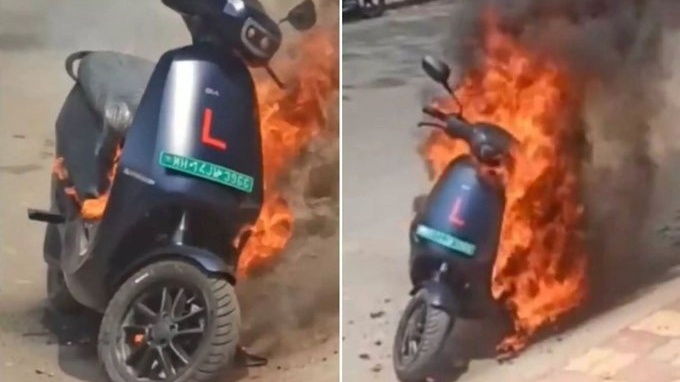Two fire mishaps in EVs, one fatal, throws up disturbing questions on their safety
The mishaps involved Ola and Okinawa e-scooters

Update: The Indian government on March 28 decided to depute a team of independent experts to investigate the two incidents of electric two-wheelers catching fire, media reports quoting government sources said.
The last weekend was not all that kind to the electric vehicles (EVs) industry in India. Two e-scooters, belonging to two different companies, were involved in fire mishaps, one of them allegedly an explosion of the battery while charging, killed two persons belonging to a family on the spot.
The two pyro-accidents --- one in Pune, Maharashtra and the other in Vellore, Tamil Nadu --- were inevitably the talking points on social media platforms, where people even more inevitably outraged over the possible safety issues in EVs.
There are calls already for the government to step in and put in place additional regulations for batteries in EVs.
With electric vehicles on the verge of becoming mainstream, the government must ensure that only the global best practices are in vogue and only the safest vehicles hit the road, the netizens felt.
Okinawa Praise Pro battery explodes while charging: Two killed
Tamil Nadu: Man, Daughter Killed After #ElectricScooter Explodes In Vellore#TamilNadu #electricVehicles #Explosionhttps://t.co/pUofxe7temMarch 26, 2022
The first of the two accidents was a fatal explosion. The battery of Okinawa Praise Pro reportedly blew up while it was left to charge in a house in Vellore, Tamil Nadu. In the tragic incident, the owner of the e-scooter and his daughter died after the vehicle went up in flames. As it happened, he had bought the e-scooter only a few days ago.
Media reports of the accident are, however, not clear. Some say the battery of the vehicle exploded while charging, and some other have it that an electrical short circuit led to the EV catching fire and exploding.
Get daily insight, inspiration and deals in your inbox
Sign up for breaking news, reviews, opinion, top tech deals, and more.
This is not the first time that an e-scooter from the Okinawa stable is involved in a blaze. Last October, videos emerged of an Okinawa e-scooter getting charred in fire. Many reports had pinned the blame on the explosive nature of the lithium-ion battery in the vehicle for the blaze.
Parked Ola S1 pro catches fire
This is scary😱😱😱Ola S1 Pro Caught Fire in Maharashtra. #olas1pro pic.twitter.com/XxSvKfKmbxMarch 26, 2022
In the other mishap, which mercifully did not have any fatalities, an Ola S1 pro electric scooter was seen in flames in Pune on Saturday. The video of the fire made its way to the social media, and the 31-second clip shows the vehicle, parked on the roadside of a busy commercial area, completely engulfed in fire. While the issue is still under investigation, some have already pointed out the problems of the lithium-ion battery. But the company is conducting its own probe.
In a statement, Ola said: "We are aware of an incident in Pune that happened with one of our scooters and are investigating to understand the root cause and will share more updates in the next few days. We're in constant touch with the customer who is absolutely safe. Vehicle safety is of paramount importance at Ola and we are committed to the highest quality standards in our products. We take this incident seriously and will take appropriate action and share more in the coming days."
Govt needs to step in to ensure safety
These two incidents, happening back to back, have the potential to make people sceptical about the safety aspects, especially those relating to the battery, in electric vehicles. Of course, such incidents have also happened outside of India. But here in a country, which is not known for ensuring safety standards in its vehicles, such mishaps add to the general wariness of the public.
Experts, however, say electric vehicles catch fire less often than gasoline-powered ones, but the duration and intensity of the fires due to the implementation of lithium-ion battery systems can make the fires in electric vehicles much harder to put out.
Also, companies here are accused of cutting corners when it comes to putting reliable products inside the battery which by their very nature are highly inflammable. Battery technology is still evolving and many different types of chemistries are being tested. The industry is waiting for more efficient, stable and safer batteries.
Some companies are moving towards Lithium iron phosphate (LFP) batteries as opposed to lithium nickel manganese cobalt oxide (NMC) batteries in their vehicles. LFP batteries have a significantly higher thermal runaway threshold of 270 degrees Celsius against NMC’s 150 degrees.
Lack of standards in charging technology is also a problem. Companies want EV customers to use only OEM specified charger for specific battery type. Users must not interchange or use any non- genuine charger. Users have also been told to not charge the batteries within one hours after use. They have also been advised not to charge battery in hot conditions and never allow water to come in contact when charging.
Beyond these commonsense safety precautions, it is also equally imperative now for the government to step in and lay down some safety rules. For instance, faced with a rising number of fires in batteries, the Singapore government legislated a fire safety standard to weed out inefficient technologies.
Also, Indian government has been asked to stop the proliferation of cheap Chinese EVs flooding the Indian market. This leads to a glut of poor chargers and dubious batteries in the market, allege auto industry watchers.

Over three decades as a journalist covering current affairs, politics, sports and now technology. Former Editor of News Today, writer of humour columns across publications and a hardcore cricket and cinema enthusiast. He writes about technology trends and suggest movies and shows to watch on OTT platforms.